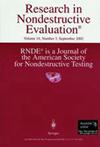聚乳酸(PLA)长丝在聚合物基增材制造(AM)中的毫米波近场评价
IF 1.6
4区 材料科学
Q3 MATERIALS SCIENCE, CHARACTERIZATION & TESTING
引用次数: 0
摘要
增材制造(AM)仍然是一个快速增长的行业,其应用范围已超出金属和其他材料,如聚合物,陶瓷和混凝土,仅举几例。然而,检测技术的发展,特别是在线无损检测(NDT)方法的进步明显滞后。开发此类方法的大多数研究都集中在金属基AM上。本文研究了三种高分辨率近场毫米波探头用于检测增材制造所用原料聚合物长丝中的小空隙的效果。本文讨论了这些探头的电磁设计和优化问题。探头的设计是基于将开放式波导的询问电场集中在与薄介质板插入片面积相对应的小区域内。这样可以获得比仅使用开放式波导更高的空间分辨率。将介质板延伸到波导外的最佳值使电场更加集中,并有可能进一步提高空间分辨率。这些修改也降低了检测灵敏度,作为增加距离的函数。然而,随着距离的增加,这些探针的空间分辨率变化更快。随后,使用v波段(50-75 GHz)的一组综合数值EM模拟对这三种探针的有效性进行了研究和比较。然后,在v波段(50-75 GHz)制作了三个这样的探针,并用于测量具有非常小的半球形表面空隙的聚乳酸(PLA)长丝的反射响应。计算了参考丝和缺陷丝之间以及模拟和测量频率范围内的均方根误差(RMSE),作为比较三种探针在整个频段内检测能力的标准。结果表明,在v波段(50-75 GHz),标准开放式矩形波导的空间分辨率足以检测到PLA材料细丝的小表面空隙。本文章由计算机程序翻译,如有差异,请以英文原文为准。
Millimeter-Wave Near-Field Evaluations of Polylactic Acid (PLA) Filament Used in Polymer-Based Additive Manufacturing (AM)
ABSTRACT Additive manufacturing (AM) remains to be a rapidly growing industry with applications that are extended beyond metals and to other materials, such as polymers, ceramics, and concrete, to name a few. However, advancement in the development of inspection techniques, particularly in-line nondestructive testing (NDT) methods, lags significantly. Most of the research in developing such methods has focused on metal-based AM. This paper investigates the efficacy of three high-resolution near-field millimeter-wave probes for detecting small voids in the feedstock polymeric filaments used for AM. The electromagnetic (EM) design and optimization of these probes are discussed in this paper. The design of the probes is based on concentrating the interrogating electric field of an open-ended waveguide in a small region corresponding to the area of a thin dielectric slab insert. This results in achieving a higher spatial resolution than when using only the open-ended waveguide. Extending the dielectric slab to an optimum value out of the waveguide makes the electric field more concentrated and potentially further improves the spatial resolution. These modifications also reduce the detection sensitivity as a function of increasing standoff distance. However, the spatial resolution of these probes varies more rapidly as the standoff distance increases. Subsequently, the efficacy of these three probes was studied and compared using a comprehensive set of numerical EM simulations at V-band (50–75 GHz). Afterward, three such probes were fabricated, at V-band (50–75 GHz), and were used to measure the reflection responses of the stock Polylactic Acid (PLA) filaments with a very small hemispherical surface void. Root-Mean-Squared-Error (RMSE), between reference and defective filaments and over the simulated and measured frequency range, was calculated as a criterion to compare the detection capability of the three probes in the entire frequency band. The results showed that at V-band (50–75 GHz) the spatial resolution of the standard open-ended rectangular waveguide is deemed sufficient detecting small surface voids of the stock PLA filaments.
求助全文
通过发布文献求助,成功后即可免费获取论文全文。
去求助
来源期刊

Research in Nondestructive Evaluation
工程技术-材料科学:表征与测试
CiteScore
2.30
自引率
0.00%
发文量
14
审稿时长
>12 weeks
期刊介绍:
Research in Nondestructive Evaluation® is the archival research journal of the American Society for Nondestructive Testing, Inc. RNDE® contains the results of original research in all areas of nondestructive evaluation (NDE). The journal covers experimental and theoretical investigations dealing with the scientific and engineering bases of NDE, its measurement and methodology, and a wide range of applications to materials and structures that relate to the entire life cycle, from manufacture to use and retirement.
Illustrative topics include advances in the underlying science of acoustic, thermal, electrical, magnetic, optical and ionizing radiation techniques and their applications to NDE problems. These problems include the nondestructive characterization of a wide variety of material properties and their degradation in service, nonintrusive sensors for monitoring manufacturing and materials processes, new techniques and combinations of techniques for detecting and characterizing hidden discontinuities and distributed damage in materials, standardization concepts and quantitative approaches for advanced NDE techniques, and long-term continuous monitoring of structures and assemblies. Of particular interest is research which elucidates how to evaluate the effects of imperfect material condition, as quantified by nondestructive measurement, on the functional performance.
 求助内容:
求助内容: 应助结果提醒方式:
应助结果提醒方式:


